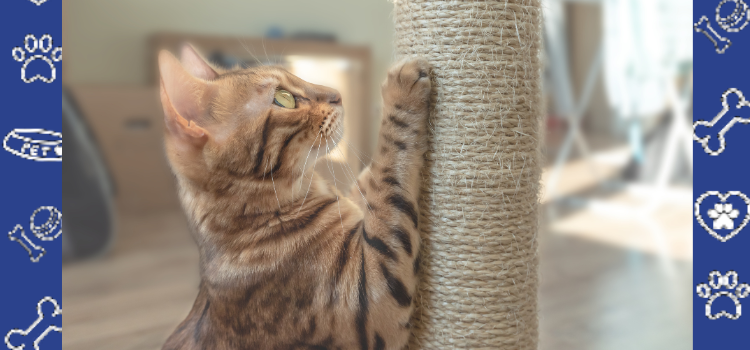How to Stop Your Cat from Scra...

How to Stop Your Cat from Scratching Everything in Sight: A Guide to Protect Your Furniture and Peace of Mind
Cats are known for their independent and curious nature, but one behavior that often frustrates cat owners is scratching. Whether it's your favorite sofa, the wooden doorframe, or your beloved rug, cats seem to have an irresistible urge to scratch everything they can find. While scratching is a natural feline instinct, it can be a problem for many pet owners, especially if you have an emotional support animal (ESA) or a service animal (PSD) living in your home. Thankfully, there are ways to address this behavior while also considering the needs of your ESA or PSD.
Why Do Cats Scratch?
Scratching is more than just a bad habit; it serves multiple purposes in a cat's life. Here are a few reasons why your cat may scratch:
- Marking Territory: Cats have scent glands in their paws, and scratching helps them mark their territory by leaving both a visual and olfactory mark.
- Stretching Muscles: Scratching allows your cat to stretch its muscles and keep its body agile.
- Sharpening Claws: Scratching helps remove the dead outer layer of a cat's claws, keeping them sharp and healthy.
While this behavior is completely natural, it can become destructive if your cat is scratching your furniture or other belongings.
How to Stop Your Cat from Scratching Everything
Fortunately, there are several steps you can take to redirect your cat's scratching behavior without causing harm or frustration.
1. Provide Scratching Posts and Pads
The first step in preventing your cat from scratching your furniture is to provide suitable alternatives. Scratching posts and pads are designed to mimic the surfaces cats love to scratch. You can choose from a variety of types, such as vertical posts, horizontal pads, or even angled scratching surfaces. Experiment with different materials like sisal, cardboard, or carpet to see which one your cat prefers.
2. Use Cat Furniture Strategically
Place scratching posts or pads near the areas your cat likes to scratch. If your cat scratches the corners of the couch, try placing a scratching post near that area to give them an alternative. Make sure the post is tall enough for them to stretch fully, as this is a major part of the appeal.
3. Nail Trimming and Soft Claws
Regularly trim your cat's claws to reduce the damage caused by scratching. You can also consider using soft claw covers, which are small plastic caps that go over the cat's claws. These prevent them from causing damage while still allowing them to scratch without harming furniture.
4. Use Cat Deterrent Sprays
If your cat is particularly persistent, there are sprays available that can deter scratching. These sprays have scents that cats find unpleasant, and they can be applied to furniture or other areas where scratching is a problem. Be sure to choose one that is safe for both your cat and your home.
5. Positive Reinforcement
Reward your cat when they use their scratching post. Positive reinforcement, such as giving them treats or praise, will help them understand that scratching the post is the desired behavior. On the other hand, avoid punishing them for scratching; this can create stress and confusion for your cat.
6. Create a Stress-Free Environment
Cats that scratch excessively may be experiencing stress or anxiety. If your cat is scratching due to boredom or frustration, providing them with more mental and physical stimulation through toys, interactive play, and window perches can help alleviate these feelings.
Addressing Emotional Support Animals (ESAs) and Psychiatric Service Dogs (PSDs)
When you have an ESA or a PSD, their well-being and comfort are just as important as the condition of your furniture. Scratching may become more problematic if you're sharing living space with these animals, as you want to create a peaceful and comfortable environment for both.
In cases where you're living in housing that doesn't allow pets, having a letter from PetCerts.com stating that your animal is an ESA or PSD can help provide the legal protections you need. This letter can allow you to keep your ESA or PSD in your home, even if the landlord typically doesn't permit pets. By making sure that your cat has appropriate outlets for their scratching behavior, you can prevent damage to your living space while also keeping your ESA or PSD happy and healthy.
Scratching is a natural and essential behavior for cats, but with the right approach, you can help protect your furniture while accommodating the needs of your feline friend. Providing alternatives like scratching posts, trimming their nails, and creating a stress-free environment will go a long way in preventing destructive scratching. Additionally, if you're living with an ESA or PSD, ensuring you have the proper documentation through a service like PetCerts.com will help make sure your living situation remains comfortable for both you and your pets.
Remember, patience and understanding are key when managing your cat’s scratching behavior, and the right solutions will keep your home safe, calm, and enjoyable for both you and your animal companions.